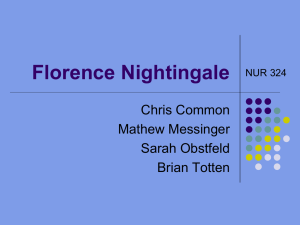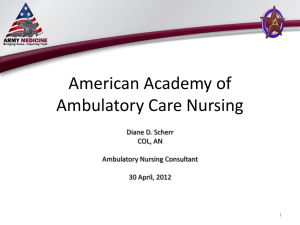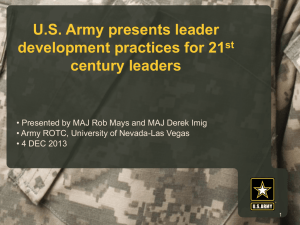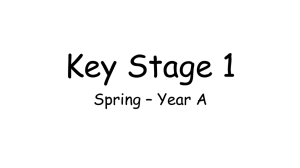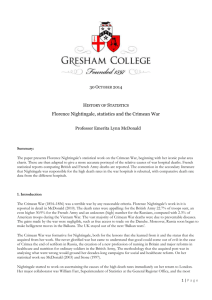for "History of Statistics: Florence Nightingale
advertisement
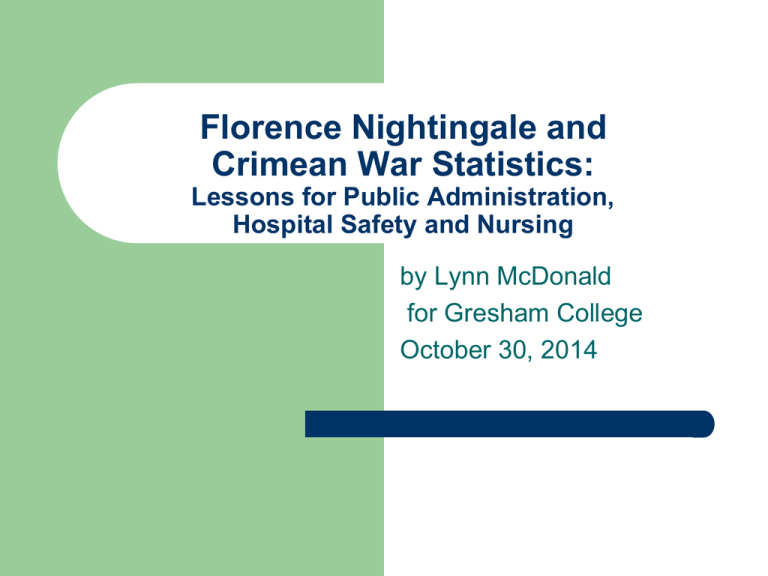
Florence Nightingale and Crimean War Statistics: Lessons for Public Administration, Hospital Safety and Nursing by Lynn McDonald for Gresham College October 30, 2014 Sources Lynn McDonald, ed.,Collected Works of Florence Nightingale (2001-12, 16 vols), of which: 2 volumes on civil nursing, 1 on health care 2 on military nursing, 1 on hospital reform, 1 on society and politics (statistics) former Canadian MP, author, Non-smokers’ Health Act, 1988 The Collected Works Of Florence Nightingale, 16 vols. 2001-12 Florence Nightingale (1820-1910) Fame from the Crimean War 1854-56 Major founder of the modern profession of nursing Social scientist, first woman Fellow of the Royal Statistical Society; pioneer of evidence-based health care Pioneer environmental health theorist (from the lessons of the Crimean War) The glorified view of the Crimean War, Jerry Barrett’s “portraits” The “Lady with the Lamp,” the enduring legacy, which can be misleading Stained glass window in a chapel in Ontario Hospital conditions in her day Death rates per admissions, at London teaching hospitals were around 10%, when her nursing school opened in 1860 In Crimean War hospitals at 40% in the worst months of the war (early 1855) British Army death rate in Crimean War 22% U.S. Army death rate in Vietnam 2.3% Nightingale’s role Much of Nightingale’s time spent on cleaning up the hospitals (faeces on the floor) getting supplies in (food, bedding, clothing) Laundries established (laundresses quit from the smell) But the significant change not until March 1855, with the Sanitary Commission Learning the lessons Nightingale saw the terrible conditions, and saw the changes made when the (civilian) experts were sent by government to the war hospitals: the Sanitary Commission (headed by Dr John Sutherland, with Robert Rawlinson, C.E.) and the Supply Commission, which improved nutrition, clothing and shelter Sewers and drains, vermin Massive clean-up, with “nuisance inspectors” from Liverpool, the city that pioneered public health measures Removed dead horses from the water supply, improved ventilation, removed tons of “filth” (faeces) from the sewers and drains Comparing the British and French The British Army made changes French Army did not The results in the statistics—overwhelming success for the British Comparison of French and British Mortality in the 2 War Winters 1st winter French British dead total effectives 10,934 89,885 10,989 47,749 percent 12% 23% 2nd winter French British 21,191 106,634 606 27,384 20% 2.2% Source: Jean Charles Chenu, De la mortalité dans l’armée et des moyens d’économiser la vie humaine (Paris: Hachette 1870) 131 Get chart in here Yet no fighting in the second winter! Different interpretations Nightingale and her team learned and applied the lessons of the war in radically reformed public administration, improved hospital design and the creation of a new profession, nursing My view--based on primary sources Other views still popular, both positive and negative False claims for patient care “Within several months of her arrival, she implemented hygiene practices--use of clean water, clean sheets and hand washing--that decreased the facility’s mortality rate to approximately that of London hospitals at that time.” Gawande, “Notes of a Surgeon: On Washing Hands,” New England Journal of Medicine 350 (2004) Some exaggerated claims for FN “She kept extensive and accurate records of military hospital conditions and mortality and differentiated deaths related to hospital conditions” (Munro, “The ‘Lady With the Lamp’ Illuminates Critical Care Today,” American Journal of Critical Care 19,4 (July 2010). Nor did she invent “triage” Negative views Hugh Small’s claim that the death rates highest at “her” hospital, and she to blame, that she was “criminally negligent” With not one table or figure to document this; yet this view taken up by nurses, many historians, the BBC, etc.--rough estimates, general and regimental hospitals compared Hospital deaths—which the worst? Mortality high everywhere, but the highest, when disaggregated data available, were at Koulali, nursed by the Irish Sisters of Mercy And this known since the war, in the official statistics collected by the War Office (which Small did not use) Note 2 last columns, Feb 1855,disaggregated figures Why the highest at Koulali? Koulali had the worst sanitary conditions, noted by Dr Sutherland in the report of the Sanitary Commission Major clean up helped, but Koulali given back to the Turks Learning the lessons Get the science right Get the best experts Get hard data Review rigorously The decline in death rates NOT from nursing care—it required structural changes—sewers and drains Lessons from Quetelet “Different treatments [have but a] small influence on the death rate” “Administration saves more hospital patients than the best medical science” (comments on Quetelet’s Physique sociale) Sidney Herbert her collaborator on improving public administration Army Sanitary Administration & its Reform under the Late Lord Herbert Row 1 Deaths in the English male pop. Row 2 Army deaths pre-Herbert Row 3 Army deaths after his (their) reforms Knowledge for application To compare results when “neglect of the laws of nature” and what may expect “from their observance” “Nature is the same everywhere, and never permits her laws to be disregarded with impunity” (“A Contribution to the Sanitary History of the British Army”) Research on surgical outcomes “The law of life after operations has not yet been ascertained. And no hospital statistics have yet been kept so as to ascertain it.” (Nightingale letter 1861) Death rates post-surgery then around 50% (pre-Lister and anti-septic surgery) Nightingale published on safety from 1858 papers to her full Notes on Hospitals, 1863 Hospital defects Four great defects of hospitals (from 1858) large numbers under one roof deficiency of space deficiency of ventilation deficiency of light Later editions of “Notes on Nursing” expanded to 16 causes Hospital-acquired infections “Every nurse ought to be careful to wash her hands very frequently during the day. If her face, too, so much the better.” Florence Nightingale, “Personal Cleanliness,” Notes on Nursing, 1860. “Proper hand hygiene is the primary method for reducing infections,” A. Gawande, in “Notes of a Surgeon On Washing Hands,” New England Journal of Medicine, 2004. Using charts Her most brilliant charts combine crosssectional data (normal death rates and excessive death rates) With longitudinal (declining death rates over time as reforms brought in) Still a model to use! 1854March ‘55 April 1855 to end of war Nightingale and Farr’s classic “polar area charts”; note break between the 2 charts on the arrival of the Sanitary Commission War hospital death rates and London peacetime hospital death rates-centre circle Y Y sanitary improvements begin, March 18, 1855 X start here Oct 1854 Comparisons No other army learned the lessons of Crimea as the British French Army: its next war, Italian Wars of Independence, 1859 At Solferino, the dead and dying left on the battlefield for days (Henri Dunant was there and went on to found the Red Cross) American Civil War Nightingale gave advice to the Northern Army (Harriet Martineau also acted for her) Her Notes on Hospitals used by both armies Nightingale concluded that, if the Americans (the North) had used her advice properly, their hospital death rates could have been 3%, instead of 10% (Wars and the War Office, vol 15:679) Franco-Prussian War, 1870-71 French Army hospital death rates in the Franco-Prussian War were 12%, although France declared war. Better than Prussian Army hospital death rates (they won the war) at 20%. British Army applied the lessons The British government acted on the comprehensive recommendations of the official royal commission (FN briefed witnesses as well as giving her own evidence) Sidney Herbert chaired the royal commission, then the 4 sub-commissions created to implement key recommendations Public administration Barrack and Hospital Improvement Commission, later called the Army Sanitary Commission (John Sutherland) Army Medical School Army Statistics Department Army Cooking School British Army death rates fell In China, reforms brought the army death rate down to 3% per year (like Crimea in the second winter, 2.2%). This in a “hostile” country, on “the opposite side of the world,” “notorious for its epidemic diseases” (15:347) British Army peacetime hospitals Netley Hospital and Herbert Hospital both overbuilt—beds provided for 10% of troops With the reforms, beds needed for only 5-6%. ‘”It is not our fault if the number of sick has fallen so much that they can’t fill their hospitals” (Nightingale letter 15:408) Unsafe hospitals “I know no class of murderers who have killed so many people as hospital architects. At this moment (1877) there are many diseases less fatal in their most wretched homes than in hospitals: i.e., hospitals secure a higher mortality.” FM advised on design: St Thomas’ London (civil), Herbert Hospital, Woolwich (army) Making hospitals safer Solution in Nightingale’s day: the “pavilion” model, in effect each pavilion (28-30 beds) became a hospital on its own In effect reducing the scope for crossinfection Plan for general military hospital, Malta Pavilion style With gardens between pavilions (each is a ward) Pavilion style plan for 120-bed regimental hospital From Nightingale, Notes on Hosp Hospitals around the world (previous) Edinburgh Royal Infirmary Royal Victoria Hospital, Montreal Johns Hopkins University Hospital, Baltimore City Hospital, Berlin (Friedrichshain) Hospital experts made the pilgrimage to London, when before Nightingale sent them to Paris Hospitals—statistics key Hospital statistics key to saving lives: they enable tracking of epidemics, judging success or failure of hospitals (mortality rates, duration of stay) “There are laws which regulate disease.” With “fixed data...the laws which regulate diseased action would become better known.” Statistics needed Yet workhouse and hospital statistics were an “unworked mine” While both types of institution were “created for the relief of human distress,” they did not know “whether they relieve it or not” (1858, at the National Association for the Promotion of Social Science) From the war to Notes on Nursing Chapters in Notes on Nursing on ventilation, cleanliness, light, nutrition, patient comfort From the causes of high death rates at the unsanitary Barrack Hospital, Scutari – environmental causes– overcrowding, lack of ventilation, faulty toilets, overflowing sewers, lousy food (scurvy frequent), polluted water, dirty bedding, vermin and faeces in clothes Environmental health Nightingale’s theory of health and nursing called “environmental” From the lessons she learned in the Crimean War Basic external factors MUST be dealt with first: clean air, water, floors, bedding, etc. To achieve good results May need political change, legislation, more money, new building, different hospital site, better training, different personnel and mode of appointment, improved reporting prodcedures Must monitor, check results (causal links are complicated) Nightingale’s methods Still needed? Hospital-acquired infections (AKA healthcare-associated infections) in U.K. estimates of 6% of hospital patients U.S. estimates 1,200,000 patients, of whom some 100,000 die Today’s challenges Antibiotic resistant pathogens pose new threats – which may require revisiting old solutions (pre-antibiotics) MRSA, Ebola Issues of priorities for spending and centrality of patient care – the same now as ever Causes of death--global (WHO) 6,000,000 cigarette smoking (increasing) 2,200,000 alcohol-attributable 2,000,000 indoor air pollution 1,700,000 diarrheal 1,700,000 HIV/AIDS 1,300,000 outdoor air pollution 1,200,000 road injuries 660,000 malaria (decreasing) 300,000 maternal (decreasing) Relevance to health care today Nightingale’s research methods and examples should be taught at the graduate level, in nursing and public health Also her policy work, briefs on legislative changes needed, new programs Useful for nursing leaders in advocacy The Nightingale method Get the best information available Use government reports and statistics Read and interview experts If the available information is inadequate collect your own: Draw up a questionnaire Consult relevant practitioners The Nightingale method Test questions (pre-test) before using When writing up, consult experts (informal peer review). practitioners who will actually use the results Use charts for major points; use stories to flesh out the data Then on to application Reports are not “self-executive” A strategy for implementation is required Media campaign Political support (all-party desirable), leading academics, NGOs Nightingale’s great legacy: both the science AND the application A stained[glass window in Chautauqua, New York This volume reports her pioneering study of maternal mortality postchildbirth Nightingale statue at The Glasgow Royal Infirmary (before the Collected Works) Nightingale statue re-located to the Main Lobby of the Glasgow Royal Infirmary, with a relief of Joseph Lister, who pioneered anti-septic surgery at Glasgow
